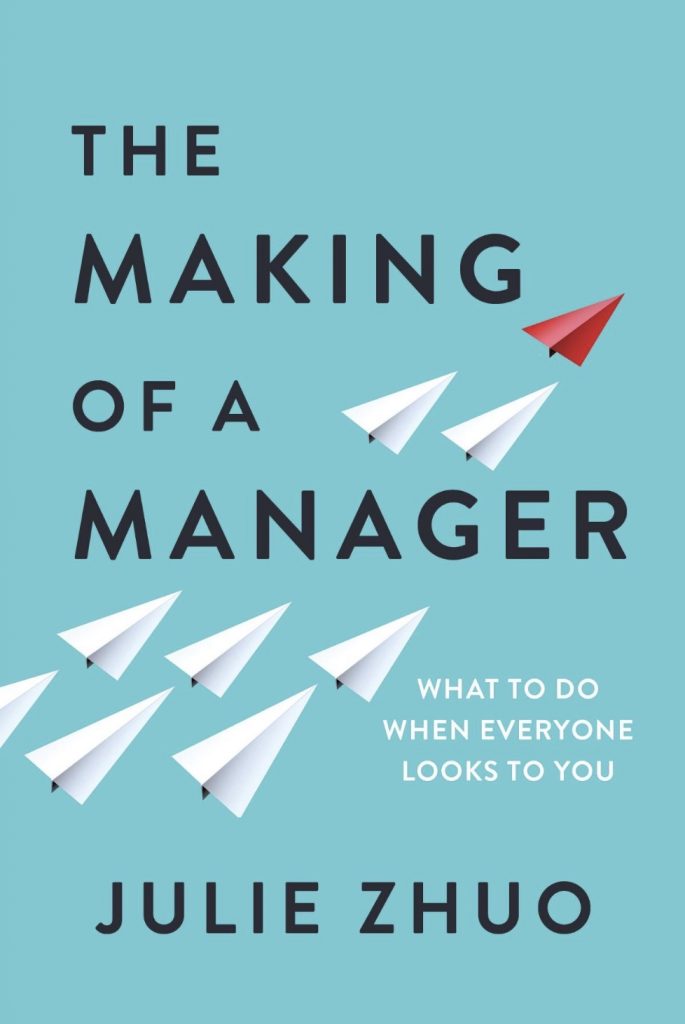Key Quote
“I believe this as deeply as I believe anything: Great managers are made, not born. It doesn’t matter who you are. If you care enough to be reading this, then you care enough to be a great manager” (p. 10). — Julie Zhuo
Key Points
What Is Management? “Your job, as a manager, is to get better outcomes from a group of people working together” (p. 19). Managing is ultimately about people, and people are complex.
Your First Three Months. Take advantage of the help and guidance offered by people and the goodwill people have for you as you start up. Understand that – unlike the people who answer to you – you own the results of what happens on your team. That fact can empower you to have hard conversations. Build on the skills you already have, and don’t feel pressure to be like your predecessor.
Leading a Small Team. Build trust by fostering honest dialogue about both problems and positives, remembering that credit for successful projects should go to the people involved. Show respect, invest time to help your reports, and be open about your own challenges and mistakes. Never tolerate jerk behavior.
The Art of Feedback. Great feedback inspires. Task-specific feedback should happen frequently. Behavioral feedback should be thoughtful, taking note of broad themes over time. “Collect 360-degree feedback” from multiple perspectives (p. 88). And if people aren’t responding, consider that you may be the problem – you might not be explaining your feedback well.
Managing Yourself. Before you can handle the tasks, troubles, and goals surrounding you, purpose to understand yourself as a person and a manager – at both your best and your worst. Ask for feedback and help from people you trust, and reach out for professional help from time to time.
Amazing Meetings. “There are only a handful of reasons for people to get together in person, so being crystal clear about the outcome you’re shooting for is the first step to running great meetings” (p. 143). People should feel “safe” contributing and should leave a meeting with “a sense of trust in the process” but also with decisions made. (pp. 143, 153).
Hiring Well. “The most important thing to remember about hiring is that hiring is not a problem to be solved but an opportunity to build the future of your organization” (p. 164). Be as precise as you can be about what you want, make “smart bets,” involve “multiple interviewers,” and “take the long view with top talent” (pp. 170, 173, 183)
Making Things Happen. Create a vision that is bold and descriptive (not vague), and work backward from that. Follow up with a “believable” plan that makes the most of your team’s strengths with clear areas of responsibility. Prioritize “perfect execution over perfect strategy” (p. 202).
Leading a Growing Team. Big teams and small teams vary in the type of management that is effective. Be aware that the larger your team and the less personal the interactions, the more intimidating you are. Pick your battles, don’t micromanage.
Nurturing Culture. Culture is “like personality” (p. 240). As a manager, never underestimate your influence on your team’s culture. Understand where your team is and where it needs to be. Talk about the culture, “walk the walk” yourself, and create incentives and traditions that reinforce and nourish values.
The Journey Is 1% Finished. Looking back, the path to success is never a neat, straight line full of only successes. There are zigs and zags, adaptations and adjustments, mistakes and triumphs. The journey is ongoing, and it will be a successful one if you build a team that works well together with a shared goal that is bigger than each individual.
Key Concepts:
What Makes a Manager?
Zhou sorts the day-to-day roles of the manager into three main buckets: “purpose, people, and process. The why, the who, and how. A great manager constantly asks herself how she can influence these levers to improve her team’s outcomes” (p. 24).
“Good design at its core is about understanding people and their needs in order to create the best possible tools for them.” Zhou says, “I’m drawn to design for a lot of the same reasons I’m drawn to management – it feels like a deeply human endeavor to empower others” (p. 8).
“Your role as a manager is not to do the work yourself, even if you are the best at it. Your role is to improve the purpose, people, and process of the team to get as high a multiplier effect on your collective outcome as you can” (pp. 25-26).
“Your job as a manager isn’t to dole out advice or ‘save the day’ – it’s to empower your report to find the answer herself. She has more context than you on the problems she’s dealing with, so she’s in the best position to uncover the solution. Let her lead the 1:1 while you listen and probe” (p. 67).
The first part in understanding how you lead is to know your strengths,” explains Zhuo. “This is crucial because great management typically comes from playing to your strengths rather than from fixing your weaknesses” (p. 112).
Cultivating Culture and Instilling Value
“Don’t underestimate the influence that you have. Even if you’re not the CEO, your actions reinforce what the company values” (p. 240).
“Pay attention to your own actions – the little things you say and do – as well as what behaviors you are rewarding or discouraging. All of it works together to tell the story of what you care about and how you believe a great team should work together” (p. 251).
“When you value something deeply, don’t shy away from talking about it. Instead, embrace telling people why it’s important to you. Assume that for the message to stick, it should be heard ten different times and said ten different ways. The more you can enlist others to help spread your message, the more likely it is to have an impact” (pp. 243-244).
“People watch their boss closely to understand the team’s values and norms. Our radars are fine-tuned to spot instances where someone in a position of authority says one thing and does another. This is one of the fastest ways to lose trust. If you’re not willing to change your behavior for a stated value, then don’t bring it up in the first place” (p. 244).
“When a report does something difficult that is in the spirit of your team’s values – passing up a lucrative sales deal because of ethical concerns, firing a star performer who is creating a toxic environment, or admitting openly when they have made a mistake – recognize them for it. Acknowledge that it was hard and thank them for doing the right thing” (p. 249).
“There is power in rituals. Beyond slogans or speeches, they create actions around which team members can bond” (p. 249).
“One of the things Mark Zuckerberg has continued to do for more than ten years is hold an internal Q&A on Friday afternoon where anybody can ask any question and get an honest answer” (p. 251).
The Art of Feedback
“Recognition for hard work, valuable skills, helpful advice, or good values can be hugely motivating if it feels genuine and specific” (p. 72).
Zhuo explains, “your words need to be thoughtfully considered and supported with specific examples to explain why you feel that way (p. 87).
“For example, after your report presents an analysis, tell her what you thought she did well and what could go better in the future. Be as precise and detailed as you can” (p. 86).
“Don’t start with a long preamble. Don’t try to sugarcoat a tough message or pad it with ‘softer’ points.” Zhuo cautions that “lobbing over a few superficial words of praise to temper a hard message comes off as insincere. Plus, the thing you actually want them to pay attention to might be lost” (p. 101).
Asking for feedback is as important as giving it. “The only hurdle you need to overcome is yourself – can you remember to ask frequently enough? Can you be humble and self-aware enough to hear it openly and then respond with real change?” (p. 131).
“Emphasize that you welcome dissenting opinions and reward those who express them” (p. 221).
Setting the Stage for Great Outcomes
“A good strategy understands the crux of the problem it’s trying to solve. It focuses a team’s unique strengths, resources, and energy on what matters the most in achieving goals” (p. 195).
“Try to connect every task, project, decision or goal with the organization’s higher-level purpose. If everyone understands the dream, the actions of the team will be aligned in making it a reality” (p. 210).
“Just like you wouldn’t send an army’s calvary on a spying mission, you shouldn’t create a plan that doesn’t match what your team is well suited for.” Zhuo adds, “The plan that is smartest for your team is one that acknowledges your relative strengths and weaknesses” (p. 196).
Avoid spending too much time in meetings “trying to get to a group to consensus rather than escalating quickly to a decision-maker” (p. 145).
If the purpose of a meeting is to generate ideas, change the meeting format to favor participation. Zhou likes to employ “Post-it note openings” before complex topics such as developing marketing goals. Each person writes down their thoughts on the Post-it, then puts them on the board for discussion before grouping them together for analysis (p. 155).
Building Your Bench of Talent
“Repeatedly talk about your values so that everyone understands what great talent looks like. And above all, make it clear that building the team isn’t just one person’s job, it’s everyone’s job” (p. 186).
“Since every hire is already a gamble, reject any weak hires. While they’re not likely to bomb, they’re also not likely to add much. If you’re going to make a bet, bet on someone with a passionate advocate behind her” (p. 174).
“Ask candidates if they can show you the applications they’ve developed, the articles they’ve written, the pitches they’ve given, etc., so you can assess the quality of their output” (p. 171).
“Recruiting top talent is all about the relationships you build.” Zhuo explains, “attracting the best people is a long-term investment. Pay attention to the rising stars of your field and get to know them through conferences, mixers, and other events.”
“Jobs may be short, but careers are long” (p. 184).
“Even when you don’t end up extending an offer, an amazing interview experience tells prospective hires that you care about the people who might be the future of your organization” (p. 169).
Zhuo says this about creating a solid manager-recruiter relationship: “By working in tandem on the interview experience, we avoided common mistakes like leaving days or weeks in between next steps, asking candidates to repeat themselves over and over, or giving them conflicting or confusing information” (p. 169).
Zhuo, J. (2019). The Making of a Manager: What to Do When Everyone Looks to You. New York: Portfolio/Penguin.

Zhuo says this about creating a solid manager-recruiter relationship: “By working in tandem on the interview experience, we avoided common mistakes like leaving days or weeks in between next steps, asking candidates to repeat themselves over and over, or giving them conflicting or confusing information.”
